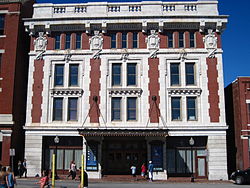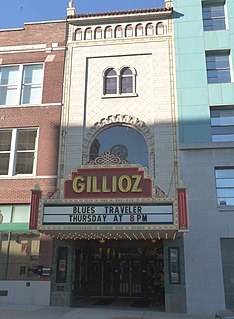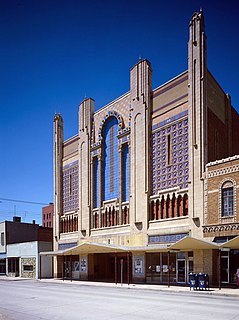Landers Theatre | |
 | |
| Location | Springfield, Missouri |
|---|---|
| Coordinates | 37°12′26.44″N93°17′26.7″W / 37.2073444°N 93.290750°W Coordinates: 37°12′26.44″N93°17′26.7″W / 37.2073444°N 93.290750°W |
| Built | 1909 |
| Architect | Carl Boller |
| Architectural style | neoclassical |
| NRHP reference # | 77000806 [1] |
| Added to NRHP | August 12, 1977 |
The Landers Theatre in Springfield, Missouri, built in 1909, is the second oldest and largest civic theater operation in Missouri. It has been in continuous use either as a legitimate theatre or a movie theater since it opened. In 1928, the theater became the 35th facility in the world to acquire sound film. It was designed by architects Carl Boller and Brother in association with Hickenlively and Mark of Springfield in a French-influenced neoclassical style. It is located in the Walnut Street Commercial Historic District.

Springfield is the third-largest city in the state of Missouri and the county seat of Greene County. As of the 2010 census, its population was 159,498. As of 2017, the Census Bureau estimated its population at 167,376. It is the principal city of the Springfield metropolitan area, which has a population of 462,369 and includes the counties of Christian, Dallas, Greene, Polk, Webster.

A theater, theatre or playhouse, is a structure where theatrical works or plays are performed, or other performances such as musical concerts may be produced. While a theater is not required for performance, a theater serves to define the performance and audience spaces. The facility is traditionally organized to provide support areas for performers, the technical crew and the audience members.

Missouri is a state in the Midwestern United States. With over six million residents, it is the 18th-most populous state of the Union. The largest urban areas are St. Louis, Kansas City, Springfield, and Columbia; the capital is Jefferson City. The state is the 21st-most extensive in area. In the South are the Ozarks, a forested highland, providing timber, minerals, and recreation. The Missouri River, after which the state is named, flows through the center of the state into the Mississippi River, which makes up Missouri's eastern border.
Contents
The theater is unusual in its use of wood for nearly all structural framing, in contrast with the steel and cast iron more usually employed in its time. D.J. Landers, the original owner, was in the lumber business, providing a possible explanation. Where steel is employed, it uses unusual bonded steel and masonry assemblies. The theater was designed for live performance, with a large stage and supporting spaces. [2]
The theater's street facade employs Missouri limestone piers with terra cotta cornices, cartouches, quoins and parapets. Infill between these decorative elements is brick. [2]

Limestone is a carbonate sedimentary rock that is often composed of the skeletal fragments of marine organisms such as coral, foraminifera, and molluscs. Its major materials are the minerals calcite and aragonite, which are different crystal forms of calcium carbonate (CaCO3). A closely related rock is dolomite, which contains a high percentage of the mineral dolomite, CaMg(CO3)2. In fact, in old USGS publications, dolomite was referred to as magnesian limestone, a term now reserved for magnesium-deficient dolomites or magnesium-rich limestones.
A fire in 1920 completely gutted the stage area, but the remainder was saved by the fireproof asbestos curtain. Subsequent renovations moved the orchestra pit behind the curtain and raised the boxes. Heavy clear-span beams replaced columns supporting the balconies, and the Jim Crow-era ticket booth for "coloreds" and its separate entrance were removed. [2]

Asbestos is a set of six naturally occurring silicate minerals, which all have in common their asbestiform habit: i.e., long, thin fibrous crystals, with each visible fiber composed of millions of microscopic "fibrils" that can be released by abrasion and other processes. The minerals are chrysotile, amosite, crocidolite, tremolite, anthophyllite, and actinolite.

An orchestra is a large instrumental ensemble typical of classical music, which combines instruments from different families, including bowed string instruments such as the violin, viola, cello, and double bass, brass instruments such as the horn, trumpet, trombone and tuba, woodwinds such as the flute, oboe, clarinet and bassoon, and percussion instruments such as the timpani, bass drum, triangle, snare drum, cymbals, and mallet percussion instruments each grouped in sections. Other instruments such as the piano and celesta may sometimes appear in a fifth keyboard section or may stand alone, as may the concert harp and, for performances of some modern compositions, electronic instruments.
From March 17–September 22, 1961, NBC-TV carried a live country music variety program from the theater, Five Star Jubilee , on Friday nights; the first network color television series to originate outside of New York City or Hollywood. First-run films continued to be shown on the other six nights of the week. [3]
Country music, also known as country and western, and hillbilly music, is a genre of popular music that originated in the southern United States in the early 1920s. It takes its roots from genres such as American folk music and blues.

Five Star Jubilee is an American country music variety show carried by NBC-TV from March 17–September 22, 1961. The live program, a spin-off of ABC-TV's Jubilee USA, was the first network color television series to originate outside New York City or Hollywood.

Color television is a television transmission technology that includes information on the color of the picture, so the video image can be displayed in color on the television set. It is an improvement on the earliest television technology, monochrome or black and white television, in which the image is displayed in shades of gray (grayscale). Television broadcasting stations and networks in most parts of the world upgraded from black and white to color transmission in the 1970s and 1980s. The invention of color television standards is an important part of the history of television, and it is described in the technology of television article.
Landers was placed on the National Register of Historic Places in 1977, significant for the preserved Baroque Renaissance, Napoleon architectural style. A number of major restoration projects have been undertaken, and the most recent restorations have been cited with awards from the American Institute of Architects.

The National Register of Historic Places (NRHP) is the United States federal government's official list of districts, sites, buildings, structures, and objects deemed worthy of preservation for their historical significance. A property listed in the National Register, or located within a National Register Historic District, may qualify for tax incentives derived from the total value of expenses incurred preserving the property.

An architectural style is characterized by the features that make a building or other structure notable or historically identifiable. It is a sub-class of style in the visual arts generally, and most styles in architecture related closely to the wider contemporary artistic style. A style may include such elements as form, method of construction, building materials, and regional character. Most architecture can be classified within a chronology of styles which changes over time reflecting changing fashions, beliefs and religions, or the emergence of new ideas, technology, or materials which make new styles possible.

The American Institute of Architects (AIA) is a professional organization for architects in the United States. Headquartered in Washington, D.C., the AIA offers education, government advocacy, community redevelopment, and public outreach to support the architecture profession and improve its public image. The AIA also works with other members of the design and construction team to help coordinate the building industry.
It is currently the home of the Springfield Little Theatre.




















